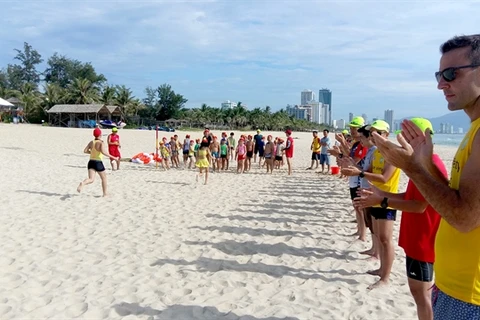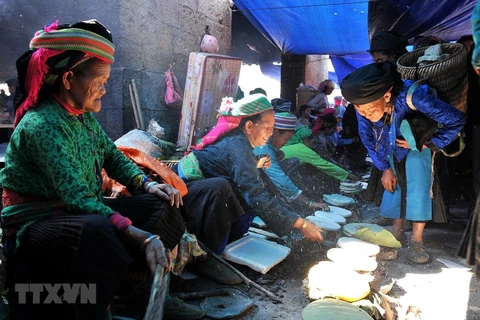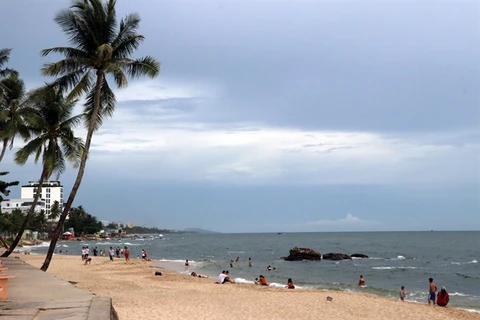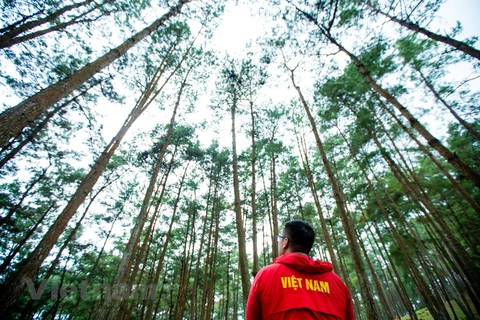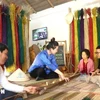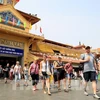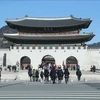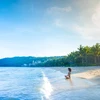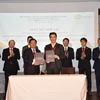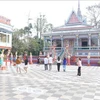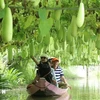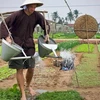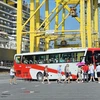Hanoi (VNA) – Foreign experts have recommended numerous priority measures, with public-private partnerships and public health priorities considered a key to the quick recovery of Vietnam’s tourism sector after the COVID-19 pandemic.
Meanwhile, domestic experts consider innovating technology and products to bring new experiences for tourists as a priority for post-pandemic tourism.
Lessons learned from history
Representing the private sector, the World Travel & Tourism Council (WTTC) includes more than 200 CEOs, Chairpersons and Presidents of the world's leading Travel & Tourism companies, of which 90 percent are operating in Asia, Europe and America.
Gloria Guevara, WTTC President & CEO, said that over the past 30 years, WTTC provided studies on economic impacts for 185 nations.
 Domestic market is considered as a solution for Vietnam’s tourism sector to overcome the ‘COVID-19 storm’ (Illustrative photo: VNA)
Domestic market is considered as a solution for Vietnam’s tourism sector to overcome the ‘COVID-19 storm’ (Illustrative photo: VNA) Guevara said that the number of people working in the tourism sector affected by the pandemic has increased from 50 million to 121 million. If no appropriate measures are taken, the figure may reach 200 million out of 230 million people working in the sector worldwide.
Together with studies on quantifying economic impacts, WTTC has also analysed crises. In its report released in November 2019, the council mentioned over 90 cases happening in the past 20 years and drew three lessons.
The first is the event on September 11, 2001, which caused a big crisis affecting the travel and tourism sector and prolonging the recovery process. One of the reasons for it is that the public and private sectors operated independently and countries introduced their own sets of conventions, thus leading to many uncertainties and inconsistencies in security procedures, especially at airports.
After 19 years, the emergence of COVID-19 made access to airports around the world increasingly difficult. The lack of standardised protocols affecting the recovery process is one of the reasons, stated Guevara.
The second lesson comes from the 2008 financial crisis. The world recovered quite quickly after 18 months in a V-chart because countries recognised the importance of public-private partnerships and established the G20 forum.
 90 events that happened in the past 20 years have left many lessons for the world economy. (Illustrative image: VNA)
90 events that happened in the past 20 years have left many lessons for the world economy. (Illustrative image: VNA) Finally, there is a lesson learned from the previous outbreaks that Asia has a lot of experience with. The SARS, MERS and EBOLA epidemics in Africa have demonstrated that people can travel without vaccines.
Experts affirm that tracing possible contacts with positive patients - as Vietnam is doing - with COVID-19 is extremely important, as 80 percent of infected people have no symptoms. Therefore, this measure is encouraged to be effective in many countries, helping them to recover faster.
The “key” to tourism recovery
Through the lessons analysed by the WTTC President & CEO, world experts have drawn four solutions, which will be the principles for recovery.
Firstly, through the 2008 crisis, the world recognised the need for an approach to higher public-private coordination, and reopening borders and removing barriers through close coordination.
Secondly, it is necessary to simplify the travel experience with two phases before and after the vaccine is produced. It is necessary to learn how to live with the pandemic.
The third action to take is the application of international conventions to regain tourists’ trust.
“The fourth is to maintain support from the Government, not only during the crisis but also to serve the recovery process to overcome difficult times,” stressed Guevara.
Meanwhile, Zurab Pololikashvili, Secretary-General of the World Tourism Organization (UNWTO), said that the pandemic requires strong resistance and right decisions at the right time.
He commended the Vietnamese Government’s vision through the establishment of the National Steering Committee for COVID-19 Prevention and Control and the timely closure of the country’s border.
 UNWTO Secretary-General Zurab Pololikashvili speaks at the national conference on tourism in Quang Nam (Photo: VNA)
UNWTO Secretary-General Zurab Pololikashvili speaks at the national conference on tourism in Quang Nam (Photo: VNA) He also pledged that the UNWTO will increase support for Vietnam as the country adapts the situation. The organisation's Global Guidelines to Restart Tourism are a suitable roadmap that emphasises the importance of public-private partnerships and public health priorities.
Chairman of the National Tourism Advisory Council and member of the Private Economic Development Research Board Tran Trong Kien affirmed that the domestic market will help revive the tourism industry in the current context.
Kien also shared three strategic solutions to enhance competitiveness for the entire industry during the post-pandemic period, including developing the domestic tourism market into an important source market that contributes 55-75 percent of the industry’s total revenue in the next 2-3 years; increasing competitiveness of the sector, and improving public-private dialogues./.



